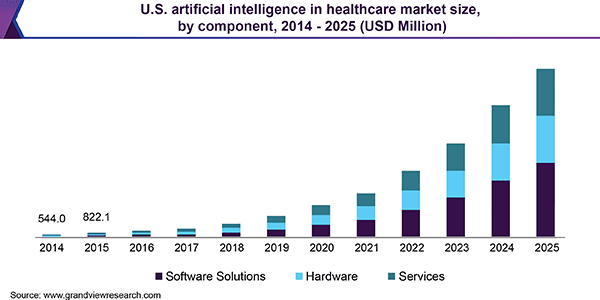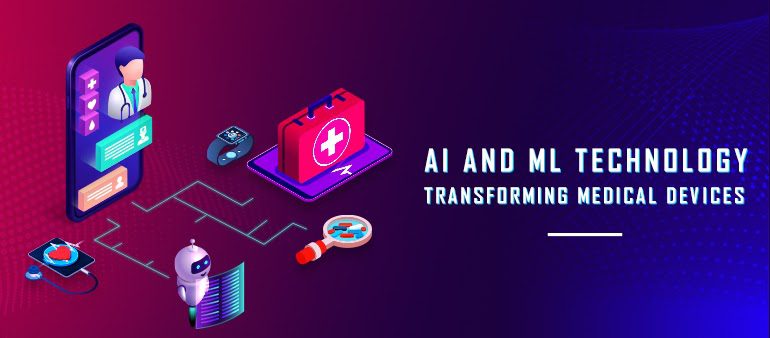Everyday of our lives, there’s tonnes of data being generated in the healthcare industry. And, we have democratized access to such data that is being used by technologies like artificial intelligence and machine learning to draw insights to not only support wireless healthcare devices but ensure that the development gears of the medical industry are greased and turning. There are medical device manufacturers making full use of AI and ML to create innovative products to assist medical practitioners in improving patient health care and at the same time ensuring safety and effectiveness of the device.
AI began its journey with autonomous vehicles, virtual assistants, and smartphones and learned people knew that there was so much more to it. Its potential has now been realized in different healthcare departments like radiology, oncology, ophthalmology, and more. We’re all well aware of the intelligent machines and softwares that AI builds and the AI technique that ML uses to develop and train software algorithms using data. These AI-powered algorithms are seen with the potential to diagnose, manage, and treat several medical conditions.
The medical device manufacturing companies have been insinuating artificial intelligence in medical systems for over 15 years now and introducing FDA-approved products. Worth noting, the FDA categorized machine learning products into Computer-Assisted Detection (CADe) devices that identifies, or highlights parts of an image using data analysis and pattern recognition whereas Computer-Assisted Diagnosis (CADx) devices evaluate and analyze diseases to specify disease type, and its severity. These devices work on machine learning algorithms and the devices in medical practice are classified into the following –
- administrative
- software-related
- clinical evidence
- non-clinical evidence, and others
Working with AI and ML-based softwares involves certain complexities and uncertainties. And keeping that in mind, the FDA has supported the use of such technologies in medical device software by making significant policies tailored for SaMD that ensure safe and reliable technology for users. The procedure involves submitting a marketing application with details such as the submission type and other data requirements based on the risk of the SaMD notification (510(k)) to the FDA, subsequent to which the specialized medical devices can be distributed.
Thus, It is crucial for companies and businesses that use AI and ML technology to be cognizant of the regulatory framework proposal by the FDA. This knowledge can be useful for them at the time of any launch or update release of any SaMD software.
The two kinds of Algorithms
Developers use machine learning to build algorithms that are locked which means that their role and functions do not change perpetually as the same data is provided to it. Thus, the unchanged functions and the same output received makes the algorithm not adaptive but locked. And, it turns out that FDA approves AI/ML-based SaMD that only include algorithms that are “locked”. The example of such algorithms are decision trees, and complex classifiers.
However, not all algorithms of AI/ML-based SaMD are locked but some are adaptive with time. These SaMDs have the ability to continuously learn and adapt with change in the algorithm. Example being a continuous learning algorithm. However, the results generated in both the cases of algorithms are different.
Microsoft’s Project Hanover
Bill Gates said, “The two areas that are changing are information technology and medical technology. Those are the things that the world will be very different 20 years from now than it is today.”

Grandviewresearch.com
About a few years back, Microsoft made its contribution towards healthcare tech by investing their time and expertise to address a big disease like Cancer. The idea was to use artificial intelligence and machine learning in medicine to find a cure for cancer. This big project was carried out through mini initiatives that included machine learning, cancer decision support, and chronic disease management. The machine learning techniques are used to analyze tumors and design new medication systems.
Every patient has a set of genes that differs from others and these sets determine the appropriate treatment for them. This is known as precision medicine which provides medical treatment that is tailored for patients.
Cancer develops differently in different patients’ bodies. Project Hanover is an initiative that works towards creating ways to improve the lives of those with chronic diseases and provide personalized treatment and medicines, and create better chances of survival.
IBM Watson Health
Along with doing well in the corporate world, IBM took a “moon shot” in 2014 when they took a step towards transforming medicine with artificial intelligence. IBM Watson was introduced with an eidetic memory and capability to support oodles of medical literature. Watson holds the knowledge of all diseases, even the rare ones. It holds the potential of cracking open a tough case in just a few seconds. This level of expertise in hospitals and clinics is expected to reduce diagnostic errors, optimize treatments, and resolve the issue of doctor shortages by helping them do their tasks faster and better.
Some real-world examples
A few use cases of AI & ML technologies that are overhauling the medicine and healthcare sector across the world are curated below.
Imaging systems for diagnosis – Artificial intelligence has dynamic and intimidating capabilities. Out of many, one is to assist clinicians with diagnosis of skin cancer by building computer-aided diagnostic solutions. The cases of skin cancer are increasing with time and many people are still not well aware of the medical condition. With the large available dataset of skin lesions and the deep learning algorithms in AI systems, the developers have made it possible to discern and classify malignant skin lesions and benign lesions by observing different clinical and dermoscopic images. Despite the various claims of AI systems achieving higher accuracy than dermatologists in the classification of different skin lesions, these AI systems are still in the very early stages of clinical application in terms of being ready to aid clinicians in the diagnosis of skin cancers.
Ironically, the advancements in the digital image-based AI solutions for the diagnosis of skin cancer brings along some challenges but also future opportunities to support dermatologists and enhance their ability to diagnose skin cancer.
Smart electrocardiograms – AI Wearable health technology has made it viable for patients to monitor heart rhythm anywhere anytime using deep-learning algorithms in wireless electrocardiogram devices. It identifies rhythmic irregularities and mechanical dysfunctions and assists with healthcare decisions. The device gauges the electrical impulses in the heart, the signal for heart muscle contraction and the one for pumping blood to the rest of the body. The features of the electrical impulses enables doctors to determine whether a patient’s heart is beating normally.
In January 8, 2019, a Mayo Clinic study applied artificial intelligence (AI) to an inexpensive electrocardiogram (EKG) which resulted in a simple early indicator test of asymptomatic left ventricular dysfunction, a precursor to heart failure. A smart electrocardiogram (ECG) device estimates the probability of a heart attack
AI-assisted stethoscopes – AI’s vast potential can turn the tables for the medical industry. It is powerful and with technologies developing rapidly over the years, a computer-assisted stethoscope was developed that helped clinicians by offering them real-time help in identifying respiratory sounds (normal, rhonchi, wheezes, fine crackles, and coarse crackles). It was a challenging task but the different respiratory sounds had different frequencies. Thus, the AI-assisted stethoscope uses an algorithm that physically and mathematically categorizes the lung sounds into five groups based upon the duration, frequency, and strength of the sound. This can also be used by patients at home.
AI/ML-Based Software as a Medical Device (SaMD)
Artificial intelligence and machine learning are helping diagnose patients more incisively so they could be treated more effectively. Hence, the International Medical Device Regulators Forum (IMDRF) defines software as a medical device (SaMD) as “software intended to be used for one or more medical purposes that perform these purposes without being part of a hardware medical device.” The industry and healthcare providers refer to such softwares as “standalone software or medical device software.
ML, a technique of AI creates models with intelligent behavior that are based on statistical analysis of data. It trains and designs software algorithms to learn an act using data. This technique in healthcare under the FD&C Act is introduced with the intention of treating, diagnosing, curing, mitigating, and preventing diseases and other medical conditions.
AI/ML’s ability to learn from real-world experience comes out as a great advantage for softwares and leaves an outsized impact on every industry it touches. The algorithms train and adapt by taking real-world feedback and improves its performance gives these inventions their own place among other SaMDs. AI/ML-based SaMD’s focuses more on improving the quality of care for patients by automating tasks and contributing towards achieving faster and improved results.
The abundance of healthcare data that is available and the on growing big data analytics has made the healthcare industry more permeable to AI and ML technology. And, the Food and Drug Administration (FDA) encourages innovation and advancement and also ensures that the proposed regulatory framework is followed. Like in the medical industry, with the technologies strengthening and progressing with time, their integration into different business segments contribute towards their reinforcement.
There are several artificial intelligence development companies in India with competent, curious, and focused developers that contribute towards the advancement of such technologies. They in their own way empower the doctors and the healthcare industry by bringing solutions to unthinkable and untold problems.































